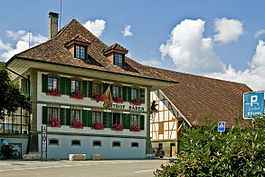Utzenstorf
| Utzenstorf | ||
|---|---|---|

Gasthof Bären in Utzenstorf village
|
||
|
||
| Coordinates: 47°8′N 7°33′E / 47.133°N 7.550°ECoordinates: 47°8′N 7°33′E / 47.133°N 7.550°E | ||
| Country | Switzerland | |
| Canton | Bern | |
| District | Emmental | |
| Area | ||
| • Total | 16.93 km2 (6.54 sq mi) | |
| Elevation | 476 m (1,562 ft) | |
| Population (Dec 2015) | ||
| • Total | 4,213 | |
| • Density | 250/km2 (640/sq mi) | |
| Postal code | 3427 | |
| SFOS number | 0552 | |
| Surrounded by | Aefligen, Bätterkinden, Ersigen, Kirchberg, Koppigen, Niederösch, Obergerlafingen (SO), Oberösch, Rüdtligen-Alchenflüh, Wiler bei Utzenstorf, Zielebach | |
| Website |
www SFSO statistics |
|
Utzenstorf is a municipality in the administrative district of Emmental in the canton of Bern in Switzerland. It is regionally famous for its medieval castle, Landshut Castle.
Utzenstorf is first mentioned in 1175 as Uzansdorf.
The oldest trace of a settlement in the municipality is the neolithic hilltop settlement at Bürglenhubel. The Bürglenhubel site includes traces of an earthen wall, turf houses and flint tools. There are several other prehistoric sites in the municipality, including scatter neolithic items at Lindenrain and a La Tene culture grave at Schnäggefeld.
When the area was part of the Kingdom of Burgundy, the county of Uranestorfus was mentioned in a record from 1009. Under the Dukes of Zähringen Landshut Castle was the administrative center of the Amt or township of Utzenstorf. The Amt included both the upper village (Ober-Utzenstorf) and the lower village (Unter-Utzenstorf) and included ownership of all land along with the right to hold both the high and low courts. When the Zähringen line died out, the Amt was inherited by the Counts of Kyburg. During the Gümmenenkrieg in 1332, the castle was attacked by troops from Bern and Solothurn and destroyed. It was rebuilt shortly thereafter. At the end of the 14th century, the Kyburgs were forced to pawn the castle and the Amt. It was acquired by Rudolf von Ringoltingen from Bern, who combined several estates into the Amt. In 1479 Ludwig von Diesbach inherited the estate from the Ringoltingen family. However, in 1514 the city of Bern bought the castle and Amt from the Diesbachs. Under Bernese rule, the castle became the center of the bailiwick of Landshut.
...
Wikipedia




